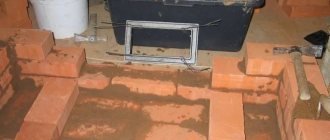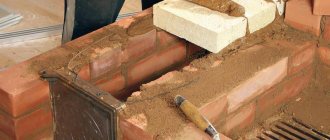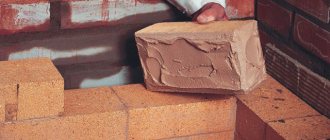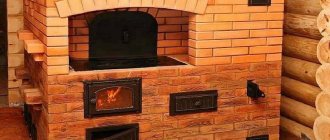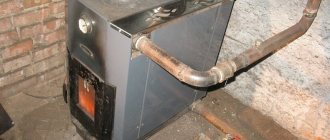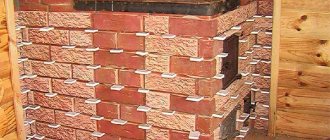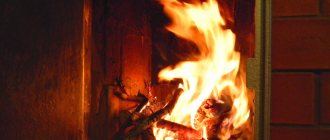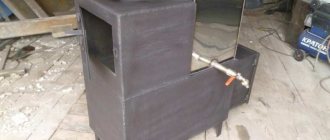Furnace technologies are very conservative, since they are refined to the detail.
Like many centuries ago, modern craftsmen require clay for laying stoves - the main component of the mortar, similar in composition to the brick itself.
An average of 3 buckets of this mortar is consumed for every 100 bricks. And it must be a solution made according to all the rules. Let's reveal the secrets of experienced stove makers.
General characteristics of clay mortar for laying stoves
- Heat resistance up to 1100 degrees is the main advantage of clay mortar. More precisely, it not only withstands temperatures, but also hardens and hardens.
- The cost of the composition is minimal. With a successful combination of natural resources, it can be completely free.
- The mixture does not set, but dries. Under the influence of water, it softens again, which allows you to sort out the oven and correct the error.
- Gas tightness – maximum (means that flue gases will not pass through the seams). At the same time, the oven allows moisture to pass through, since water has fewer molecules. This is the optimal combination; such a stove breathes.
- The shelf life, even for a mixed solution, is quite long. If you cover it with a damp cloth, it will not harden for a long time (can be prepared several weeks before work).
- Clay can dry out and shrink. Sand does not shrink, its volume is constant. Therefore, this component must be present in the solution.
There are also disadvantages. When choosing between a purchased composition and a homemade solution, you should take into account that the latter:
- Cannot be used outdoors.
- It will require patience, labor and cooking skills.
However, it is not recommended to use clay mortar for the firebox. It requires the use of more heat-resistant fireclay bricks in combination with a special solution for fireclay bricks.
You should not try to give the clay additional strength by adding cement, salt, or any other components.
If you choose the right composition, maintain the thickness of the seams and comply with other requirements, the stove will last for half a century without additives.
How to choose correctly
The masonry mortar plays a major role in giving it the necessary properties and influences the convenience of the work performed, so this creates the need to carefully combine all the components included in the composition so as not to get a negative result.
So, why is sand needed in the solution?
Before you know which sand is best, you need to determine what role it plays in the production of the solution.
It is the main filler, which is extremely important for the composition
Its functions are as follows:
- correct minor surface irregularities in bricks;
- form the volume of solution;
- smooth out shrinkage;
- give a certain color.
First, you need the sand to be as clean as possible, since the quality of the solution is affected by clay - it does not allow water to pass through, which can lead to the appearance of lumps. However, other types of pollution are just as harmful.
If there are at least some foreign particles present in the sand, the solution may lose its homogeneity. At the same time, its ductility will decrease, which will complicate the alignment of rows when laying bricks. For this reason, it is best to sift the sand.
For laying, medium sand is suitable, but for rough work it is permissible to use a coarser version. And in the case of decorative wall decoration, it is optimal to use the finest sand.
Methods for selecting clay and sand ratios
The mixture will include three components:
Many people are interested in the proportions of clay and sand for laying the stove. No one can say in what proportions to mix these components in your case, since the quality of clay in different places is completely different.
The finished composition should be plastic, but not too greasy, and not too dry (skinny, with too much sand). The greasy solution, when dried, decreases in volume and cracks. Skinny can crumble, it is not strong enough.
The properties of clay are determined by its proportional composition (sand, SiO2, Al2O3 and other impurities).
The fat content of the clay and how much sand will need to be added are determined experimentally.
Clay fat test
The test is very simple.
Take a lump smaller than your fist, knead it with wet hands and roll it into a ball.
The ball is placed between two smooth boards (metal or planed boards) and begins to be slowly compressed.
This is done until cracks appear.
Ideally, cracking should appear when the ball is compressed by no less than 1/3 of its diameter. After a couple more tests, which also show a positive result, you can lay bricks on such clay! However, such luck does not happen often.
If the clay ball cracks almost immediately, it contains a lot of sand. If it smoothly shrinks by more than half, the clay is too oily.
At what depth should I take clay for the stove mortar? The upper layers usually contain loam. Skinny raw materials with a large proportion of sand. Clay, as a rule, is located lower and the deeper it is, the more its fat content increases.
Flagella
The thickness of the bundle is 15-20 mm thick and 200-250 mm long. A freshly rolled rope is wrapped around a stick 40 - 50 mm in diameter. The normal result is that small cracks will appear on the surface. It won’t crack at all – it’s oily. And it will crack with deep cracks - skinny.
Other checks: ball and cake
A ball is rolled and a small flat cake (4–5 cm in diameter) is made. Both samples are completely dried, this will take 2 – 3 days.
If during this time the edges of the cake become very cracked, the clay is oily (add a little sand and repeat). A sign of a thin composition will also be the fact that the cake crumbles when pressed.
Methods for testing clay mortars
The ball is dropped to the floor from a height of 1 m. If it completely falls apart, there is a lot of sand in the raw material (skinny). The best samples do not break at all (an acceptable result is if the sample breaks into 2-3 large pieces).
Skinny clay is the most inconvenient material to work with. Making it fat is quite difficult. To do this, the raw materials need to be tortured. The procedure involves stirring in water repeatedly and draining after the solids have settled. Sometimes stove makers mix several clays. By mixing clay with normal or high fat content to a lean sample, you can obtain a satisfactory composition.
There is an opinion that it is difficult to build a brick oven. This is true, but it’s quite possible to build a small stove yourself. Do-it-yourself brick stove for a sauna - the necessary tools and instructions for laying.
Places of its extraction
Sand is extracted from a river, from a ravine or from a quarry. There is also artificial (quartz) sand. All these types of sand differ in their characteristics. The sand extracted from the river has few foreign impurities and a fairly uniform structure. This is due to the fact that water naturally polishes every grain of sand, and they acquire an almost ideal smooth, rounded surface and attractive appearance. However, if the surface of river sand particles is too smooth, it negatively affects the ability of the particles to bind to other components of the solution, and this affects its homogeneity. There is no need to wash and sift river sand. The cost of river sand is quite high, since it is extracted in a rather expensive way from the bottom of rivers. This sand is used mainly for decorative masonry, for cladding, for the preparation of plaster mixtures, cement screeds, in the production of concrete, asphalt concrete and bricks, as drainage, as a component of grouts and paints. It is usually not used for pouring foundations and ordinary masonry. River sand can be fine-, medium- and coarse-grained. Medium-grained river sand does not shrink, which makes it ideal for masonry and plastering work. Sand can also be mined from the seabed and has similar characteristics and uses to river sand.
Sand extracted from a quarry needs washing and sifting, because... it has impurities (stone chips, clay, etc.) and is heterogeneous in the size of sand grains. The edges of the sand grains are sharp, which has a positive effect on the plasticity of the solution due to its good ability to adhere to other components of the mixture. The advantages of quarry sand: it is cheaper than river sand, and the adhesion quality of its particles is higher. Clay makes up a small portion of the impurities, and organic particles are absent. Unrefined quarry sand is used for foundations, rough masonry and load-bearing wall masonry. Alluvial quarry sand can be used for the manufacture of bricks, plaster mortars, cement screeds, in finishing works, concrete production, and for pouring foundations.
Gully sand is also very common and is mined by open pit mining. The depth of its occurrence is very small - from several tens of centimeters to several tens of meters. Sand grains have a rough and angular surface, which has a positive effect on adhesion. There are also impurities, so it needs to be cleaned. Of the impurities in gully sand, most of them are clay and organic compounds. This gives the ravine sand mortar good plasticity, which is why it is this sand that is most often used for brickwork. Its cost is lower than that of the river one.
Artificial, or quartz, sand is sand that is not a creation of nature, but is obtained as a result of mechanical grinding of rocks containing quartz. This sand has a homogeneous structure and does not contain impurities. Thus, when deciding which sand to use for bricklaying, you first need to decide what type of masonry will be produced, and then decide which type of sand will be easier and cheaper to purchase and deliver.
Clay mortar for laying stoves: preparation methods
So, let's look at how to prepare clay for laying a stove.
Preparation steps: It is best to soak and mix the composition in a large tub using a wooden paddle.
For straining, a sieve with a wire mesh is used (the total mass is collected in buckets and delivered to the work site). Large impurities remaining on the sieve are removed. The viscous mass is pressed through with your fingers.
The water that is best suited for this work is soft (artesian, rain or snow).
A large amount of clay raw material is mixed with a paddle. It is inconvenient to use a trowel, and it is not recommended to use mechanization methods (such as a concrete mixer), since vibration can cause small spaces filled with liquid to form in the solution, and uniformity is very important for stove masonry.
Medium plastic clay mixture
The plasticity of clay depends on the amount of clay substance in the composition.
A test batch is made. All proportions are fixed so that when a successful option is obtained, the recipe can be reproduced on a larger scale. A thoroughly mixed mixture of clay, sand and water is tested for plasticity, or fluidity.
Test - is there enough water?
Run a trowel over the surface of the clay, as if removing the top layer. If the surface under the trowel is torn and “dry,” you need to add water.
On the contrary, it happens that the solution floats, and if you leave it for a while, water comes out. This excess water is drained and measured.
By comparing its volume with the one that was initially filled, you can get a fairly accurate amount of water that is actually needed.
The kneading can be considered successful if there is an even trail behind the trowel. The edges should be clear, without jagged edges and not run down.
Test - is there enough sand?
A trowel is dipped into the prepared solution. Ideally, the layer remaining on the surface should be thin and flow in wagging streams, through which the metal will be visible. If the layer is continuous, there is still a lot of fat content.
Another way: add enough clay to water (10 l) to make a creamy solution. A wooden board is lowered into the solution, the clay is stirred with it, and then removed.
If a layer of about 2 mm has settled on the surface of the wood, the plasticity of the clay is just right . A thin layer, less than 1 mm, indicates that the solution is low-plastic (oily clay is added). And a thickness of more than 2.5 mm indicates excessive plasticity (sand is added).
Categories of sand as a building material
This building material is usually divided into the following categories:
Scheme of deep-sea sand mining.
- Ravine. This material is mined in an open pit without forming a quarry. Typically, the sizes of elementary particles range from 0.15 to 3 mm. Their surface is rough and their shape is angular. Advantage: the solution using this sand becomes very strong. Disadvantage: contains many impurities.
- River. It is considered the most profitable because it is mined from the bottom of the river and does not require purification. Sand grains can be of different sizes. Typically, such sand is used for laying facing bricks, but can also be used as a filler for concrete production. In addition, it is customary to include it in asphalt concrete mixtures when laying roads, as well as when forming drainage and as a filler for dyes and grouts.
- Career. This is sand that lies under the ground, but at a small depth from the surface, so its extraction requires the formation of a quarry as a way to develop a mineral deposit.
In addition, there is a classification based on the size of sand grains. There are:
- small - up to 0.2 cm;
- medium - from 0.2 to 0.28 cm;
- large - from 0.29 cm and more.
Determining the quality of clay
The main indicator is fat content. There are fatty and lean clays. When the first one dries, it significantly decreases in volume and cracks, while the second one crumbles.
Clay can be fatty or skinny
Let us immediately note that there is no strictly defined ratio of sand and clay to obtain a good solution. Proportions are determined experimentally, by selection depending on the fat content of the rock.
The fat content of clay rock can be determined in the following way. Roll out ropes of clay, taking a thickness of 10–15 mm and a length of 15–20 cm. Wrap them in a wooden mold with a diameter of 50 mm. If the clay is oily, then the rope stretches gradually, without cracks appearing. Normal ensures smooth stretching of the bundle and breaks, reaching a thickness of 15–20% of the original diameter.
Cleaning from impurities
For the stove solution you need clean sand. To separate it from impurities, it must first be sifted and then washed. For sifting, a fine mesh sieve with a mesh size of 1.5 mm is used. Next, the sand is washed as follows: a sack with sagging is pulled onto the holder (you should get a kind of net), into which the sand mixture is placed. The structure is fixed on a stand, sand is poured in and it is washed using a hose and a stream of water. The process continues until the water flowing from the sand becomes clean.
The clay is mixed with water and left to soak.
To remove foreign impurities from the clay, it is washed. Grind, place in the upper part of an oblong container (for example, an old trough or bathtub). The container is installed at an angle of 4–8°. Water is poured into the lower part so that it is at the top and does not touch the clay. Use a small spatula or iron scoop to wash the clay. Gradually it softens and a homogeneous paste-like substance forms at the bottom, which is carefully transferred to another container. The process is continued until the required amount of solution is obtained.
Sand is sifted through a fine mesh sieve
If you purchased packaged dry clay, you need to soak it. The process of saturating clay with water is quite simple. To work, take a wide and deep container, fill it with dry clay to a level of 10–20 cm, level it and add water. The amount of water is so that everything is completely covered. After a day, mix thoroughly with a shovel, add liquid if necessary and leave again for the same period. When everything turns into a paste, the clay is ready. This is repeated several times until all the required amount is soaked.
Helpful information
Masonry methods
Bricks are laid according to special rules so that the building structure is monolithic and durable.
All dosages when preparing masonry mixture must be observed exactly.
Water consumption:
- Concrete grade 100, take 1 part cement from 1/2 to 7/10 parts water;
- Cement-sand mortar. Use 8/10 parts water for one part of cement.
Cement consumption:
- Brand M100 – 300-250 kg per m3;
- M150 - 400-330 kg per m3;
- M200 - 490-410 kg per m3;
- M300 - 600-510 kg per m3.
Preparation of stove solutions: types, applications, recipes
When performing furnace work, different solutions are prepared for different purposes:
- foundation installation;
- furnace masonry;
- plastering and facing works.
For these purposes, solutions are used:
- clay;
- lime-clay;
- sand-cement;
- lime.
The stoves are placed on clay mortar , adding a little salt or cement for strength. Many people use only clay with water, without additives. To make mixing the mortar easier, some stove makers make wooden flooring from boards with low sides. The wide working mixing area allows for better preparation of the solution.
The stoves are placed on a clay-sand mortar
First you need to determine how much material you will need. The calculation is as follows: when laying 50 bricks flat with a seam thickness of 3–5 mm, about 20 liters of masonry mixture will be required (we increase by 15–20% if we are building a Russian stove).
Clay mortar is used for the main structure of the furnace; it can also be used for lining. Consists of clay and water. Sometimes filler is added: sawdust, shavings, construction sand. The clay mixture is prepared in the following proportion : 1 part filler is added to 2 parts clay. More often than others, clay-sand mortar is used for laying the stove.
The ingredients are mixed into a homogeneous mass until creamy. The masonry mass should come off the shovel well and leave no traces. Also, no separated water should appear on the surface - if this happens, you need to add sand. To give greater strength, salt is added to the solution: 100–250 grams per bucket of solution. Cement is used less often - 750 grams per bucket.
How to prepare mortar for laying stoves is demonstrated in the video. At the same time, you will see the consistency to which you need to soak the clay. Sand-cement mortar is used to level out uneven surfaces and oven cladding (tiles, mosaics, stones). Cement mortar for the furnace is used to seal joints when laying the foundation. It is prepared as follows: measure out the required amount of construction sand and cement, mix well, fill with water to the desired consistency - such a state when it is sufficiently mobile and is squeezed out of the seam without much pressure. The proportions of materials depend on the brand of cement composition, most often 1:2.
Limestone is used as a mortar for plastering stoves, for laying foundations and pipes. Its preparation is completely different. First, the lime is slaked and kept in a special pit for about a week. After this, prepare a solution with sand. The ratio depends on the fat content of the lime (usually 1:2 or 1:3).
Lime-clay mortars with the addition of asbestos are also used for plastering the stove to give greater strength. The proportions of the solutions are as follows:
- clay-lime dough-sand-asbestos 1:1:2:0.1;
- clay-sand-cement-asbestos in the same ratio;
- gypsum-sand-lime paste-asbestos 1:1:2:0.2.
The preparation technology consists of combining all the dry ingredients and adding clay, gypsum or milk of lime diluted with water. Then the components are mixed until smooth.
There is a fireproof (fireclay) mortar for laying the core of furnaces. To prepare it, mix fireclay and fireclay in a 1:1 ratio, then add water (a quarter of the clay mass) and mix well.
This is what a good mortar on fireclay brick looks like
It is necessary to monitor the quality of the solution. After all, only a sufficiently plastic composition can ensure good adhesion of the stove masonry and tightness of the seams.
Description of main components
Careful selection of the main components of cement mortar will allow you to prepare a high-quality mass that will ensure durable brickwork. To do this you need:
- Mixing water is required to be clean, free from impurities, dirt and foreign substances. It is ideal to get it from a well. The temperature of the liquid depends on the season when it is necessary to prepare the cement mass: in summer, cold water is suitable, in winter it needs additional heating.
- Sand is an integral component of the cement composition. The absence of traces of clay and other impurities is a prerequisite, otherwise the period of weathering of the mortar from the masonry will accelerate.
- The main component that determines the properties of the future composition is cement. In order to correctly prepare the solution and maintain the correct proportions, the brand of the cement mixture is of key importance. There is a pattern: the higher the brand of the binder, the less volume is needed to prepare the solution. If you want to prepare a composition of a darker shade, just add graphite or soot to it or purchase a higher grade of cement. At the same time, it is imperative to ensure compliance with the established proportions!
- Detergents will help you prepare cement mass without purchasing expensive plasticizers. Shampoo, washing powder or dishwashing liquid are suitable for this role. The exception is cleaning agent due to the likelihood of cracks in the brickwork.
Determining the proportion of the solution
The plasticity and fat content of the masonry mortar is regulated by the addition of sand. You can determine the proportions as follows:
- Take some clay and distribute it into 5 equal parts, of which we put sand in 4 portions in the amount of 1/4, 1/2, 1 and 1.5, and leave one without sand. After adding water, knead each separately. The resulting blanks should be plastic and not stick to your hands. Flat pancakes are formed from them and dried. The quality of the mass is determined in this way: if the workpiece crumbles, then there is more sand than necessary, and the presence of cracks indicates its deficiency. It is optimal if the sample remains without cracks and is homogeneous.
After drying, a good solution does not crack
Having experimentally determined the required proportion of sand and clay in the future solution, we begin to prepare the basic materials.
Stove clay is used in different situations: for home and outdoor stoves, barbecues and fireplaces. Unlike other compositions, the resulting mixture is economical and has good stability characteristics. Naturally, such a result can only be achieved with precise selection and preparation of the components, as well as following the technology of mixing the mixture.
Career
The name clearly indicates the origin of the sand. It contains clay and stones, so quarry material is used to a limited extent: for site planning, backfilling under concrete screeds or foundations.
To improve its properties, quarry sand is washed with water right at the mining site, freeing it from dust particles and clay. This is how alluvial (washed) sand is obtained. It is suitable for plastering and masonry mortars. In addition, sifting through sieves can be used to remove clay.
An important practical conclusion: if you are offered to buy quarry (gully) sand, do not forget to check whether it has been cleaned (washed, sifted) or not.
Areas of application of washed (sifted) quarry sand:
- cement screed, masonry and plaster mortars;
- Finishing work;
- brick production;
- foundation installation;
- preparation of concrete.
river sand
This building material is extracted by a dredger from the river bottom. There are no clay particles and very few stones in river sand. This allows you to use it for concrete work without restrictions.
It is very valuable that medium-sized river sand (1.8-2.2 mm) practically does not shrink. This makes it ideal for masonry and plastering.
Quarry sand is more difficult to use in this capacity. In the solution it settles to the bottom and has to be stirred periodically.
Areas of application of river sand:
- concrete production;
- brick production;
- masonry work and cement screed;
- preparation of asphalt concrete;
- drainage device;
- filler for paints and grouts.
Sea sand has similar properties to river sand. It is also highly valued in construction for its high purity and uniformity of particle size distribution.
Quartz sand
This material is obtained by mechanical crushing of quartz-containing rocks. It is homogeneous in structure, chemically inert and pure.
The main area of application of this type of sand is the construction materials industry. It goes into dry building mixtures, sand-lime bricks, blocks and concrete, and is used to prepare grinding compounds. Landscape design, expensive interior and facade plasters also cannot do without quartz sand.
It is impossible to unequivocally answer the question of which sand is better, since each material is intended for certain types of work.
Still, the main conclusions are already obvious:
- for brick and large-block masonry, it is better to take river sand. If you mix it with a small amount of unwashed quarry sand, the solution will become more plastic (due to clay particles);
- for concrete, coarse or medium river sand is better suited (you can add a little fine washed quarry sand to it);
- For plaster, washed quarry sand with or without a small addition of river sand is better suited.



